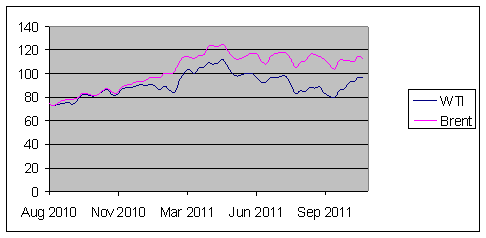The price of West Texas Intermediate has risen almost $10 a barrel since the start of September, and briefly bumped back above $100 a barrel this week. Here’s why I think that development may not be as worrisome for the U.S. economy as it might sound.
The first point to be clear about is what we mean by the price of oil. Two of the most popular benchmarks are West Texas Intermediate, which is a light sweet crude whose price is quoted for delivery in Cushing, Oklahoma, and Brent, which comes from the North Sea. The crudes are similar in terms of quality, and historically traded for a very similar price. But a year ago the two prices began to diverge, differing by as much as $28 a barrel at the beginning of September.

Blue: price of West Texas Intermediate, dollars per barrel, Aug 20, 2010 to Nov 18, 2011. Fuchsia: Brent price. Data source: EIA, with latest entries from Oil-Price.net.
That divergence resulted from a surge in production from Canada and the northern United States, coupled with a lack of transportation infrastructure necessary to move the oil from where it is now being produced to refiners on the U.S. coasts. For this reason, those refiners have been paying a much higher price for crude oil delivered by ship, with the Brent price representative of what U.S. refiners have been paying to import the oil from overseas.
The Keystone Gulf Coast Expansion Pipeline would today be providing some of that needed transportation capacity if the Obama Administration had given it the ok when the plan was first submitted for approval 3 years ago. However, the White House recently announced that it still needs at least another year to review the plan.
But there are other ways to ship the oil to where the market is signaling that the product is most needed. The Seaway Pipeline has rather astonishingly been transporting oil from the Gulf Coast, where it is expensive, to Cushing, where it is cheap, presumably because ConocoPhillips, part owner of the pipeline, wants to protect its Midwest refining margins. Craig Pirrong looked at this and suggested the logical solution would be for oil producers to buy the pipeline outright from Conoco and invest in the infrastructure adjustments necessary to get the oil flowing through the pipeline in the opposite direction.
And this week Enbridge announced it had entered into an agreement to pay $1.15 billion to buy out Conoco’s interest in the Seaway Pipeline, and further announced its intention to make pump station additions and modifications necessary to use the pipeline to transport oil from Cushing to the coast. Enbridge anticipates that it could be ready to move 150,000 barrels per day from Cushing to the coast by 2012:Q2 and 400,000 b/d by 2013.
Although oil won’t be flowing for a while, the announcement itself would be expected to cut into the Brent-WTI spread. This is because if someone in Cushing knows there’s going to be a better market to sell the WTI to next year, it makes sense to put more into inventory today (driving today’s WTI price up). Likewise, if someone on the coast knows there’s going to be a cheaper alternative next year, it makes sense to buy less for storage there (driving today’s Brent or equivalent price down). If we look at the broader trends since the start of September, what’s happened is that the WTI price is up about $9 while the price of Brent is down almost $4.
Because gasoline is transported using different infrastructure from the crude oil, the differences in the cost of crude did not translate into equally dramatic regional differences in the cost of gasoline. Whenever transportation facilities are adequate, we’d expect the law of one price to hold. If you can transport gasoline across U.S. states, the refined product should sell at a similar price as a result of physical arbitrage of the gasoline market. A big effect of the Brent-WTI spread was thus to raise refiners’ margins in the central U.S., with the price of gasoline in the U.S. tracking Brent more closely than WTI since the two prices diverged.

Blue: price of West Texas Intermediate, dollars per barrel, Aug 20, 2010 to Nov 18, 2011. Fuchsia: Brent price. Yellow: price of gasoline, scaled as 40 x (P – 0.80) for P the average U.S. weekly price of regular gasoline, all formulations. Data source: EIA, with last entry from NewJerseyGasPrices.com.
It’s worth noting that despite the big run-up in WTI, the average retail price of gasoline has followed Brent down, being about 30 cents per gallon cheaper than at the start of September. What matters most for U.S. consumers at the moment is the cost of oil imported by tanker. Insofar as the latest developments put downward pressure on that, the seemingly paradoxical result is that a higher cost of WTI may actually mean lower costs of gasoline for U.S. consumers.
But we’ve put off the problem long enough, and the size of the challenge is big enough, that more infrastructure is still needed. The Wall Street Journal reports:
U.S. oil production is expected to grow to 6.4 million barrels a day by 2016 from 4.2 million barrels a day today, according to data provided by Bentek Energy, a consultancy. And oil producers in western Canada are expected to ratchet up production to 3.5 million barrels a day by 2015 from 2.8 million in 2010, according to the Canadian Association of Petroleum Producers.
There are conflicting reports in the media ([1], [2]) as to whether Enbridge, now that it controls the Seaway, still plans to build the Wrangler Pipeline that the company announced in September, which could transport an additional 800,000 b/d from Cushing to the coast. But even if Wrangler gets canceled, the WSJ also reports:
Magellan Midstream Partners LP still plans to reverse its 700-mile Houston-to-El Paso Longhorn pipeline to deliver up to 225,000 barrels a day of crude oil from west Texas to the Houston by mid-2013, said company spokesman Bruce Heine.
The President may wish to declare that the Atlantic Ocean should be 10 feet lower at New York than it is in Florida. But the water will find a way to get there anyway.
And markets are going to figure out how to sell oil to the highest bidder.
Implications of the recent rise in oil prices
- Bulenox: Get 45% to 91% OFF ... Use Discount Code: UNO
- Risk Our Money Not Yours | Get 50% to 90% OFF ... Use Discount Code: MMBVBKSM
Disclaimer: This page contains affiliate links. If you choose to make a purchase after clicking a link, we may receive a commission at no additional cost to you. Thank you for your support!




Leave a Reply